Your Planets
Portraits of the Planets
Aspects between Planets
The planetary ages
The planetary families
Planets in Signs
The Planets in comics



For more than 2500 years astrologers have had only one concept intuitive and empirical of what the objective reality of an Aspect is. They confined themselves to observing empirically certain real effects and imagining unreal ones. Very rare and very embryonic have been the attempts at conceptualization and therefore at theorization, such as that exposed by Ptolemy in the 2nd century and that proposed by Kepler in the 17th. Both resulted in erroneous explanations and failures. It is only in the 20th century that the concept of Aspect began to be truly elaborate, making it possible to distinguish the true from the false in the antique and traditional notions and formulate a rational explanatory theory through an overall conception of astrology. The contemporary design and graphical representation of the Aspects are the product of a long history, and the very idea of Aspect has evolved over the millennia.
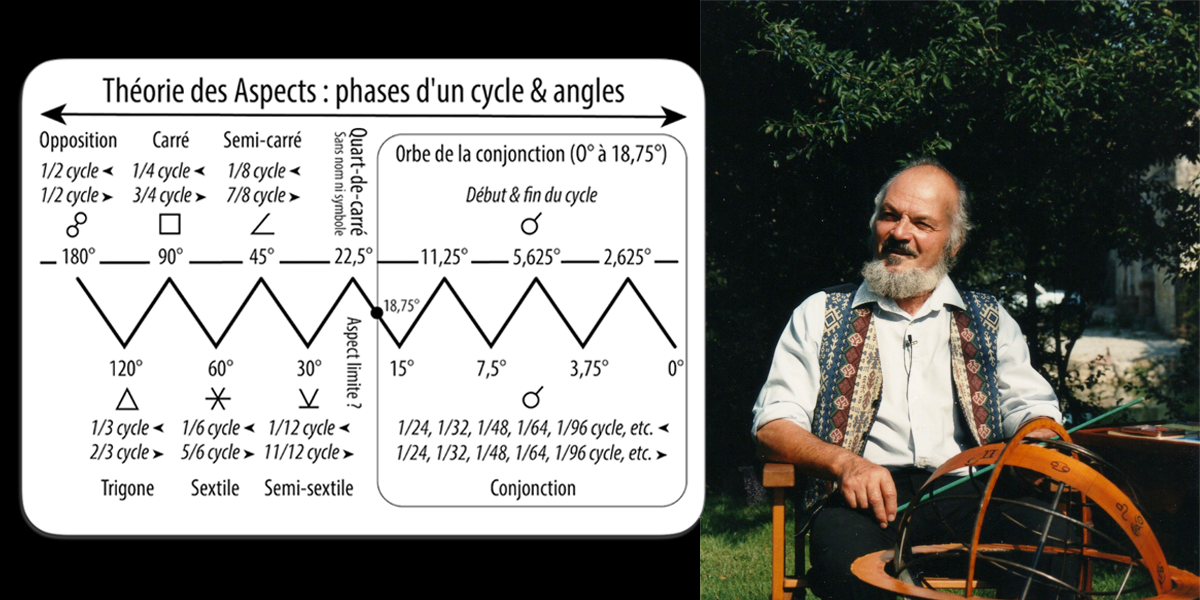
It is among other things in returning to the concerns and observations of early Mesopotamian astronomers-astrologers and in pondering Kepler’s failure that in the second half of the 20th century, the astrologer Jean-Pierre Nicola (1929) refounded the conception of the Aspects, unchanged since Ptolemy or even Kepler, which constituted a veritable epistemological break. From its founding book The Solar Condition (1964), he firmly established that the Aspects are the phases of a dynamic cycle, not the angles of a static circle, retained the idea that they self-define their orbs as a priority, and in doing so, he formulated the first coherent mathematical theory.
The video below (9′ 57″) is a commented animation of the notion of Aspect among the Sumerians and Babylonians.
We will not dwell here on the details of this mathematical theory, since it is displayed elsewhere on this site. To briefly comment on the figure above, this explanation by Nicola will suffice: “In summary: There is the conjunction which contains in its margin of effect all the harmonics of the dissonant and consonant aspects, and there is the sequence of dissonants obtained by the divisors 2, 4, 8 then the sequence of consonants obtained by the mean divisors of the preceding: 3 (trigon) being the mean of 2 plus 4, as 6 is the arithmetic mean of 4 plus 8.” This astronomical theory, at the level of the transmitter, is completed at the level of the human receiver by one theory on the reflexological foundations of the Aspects.
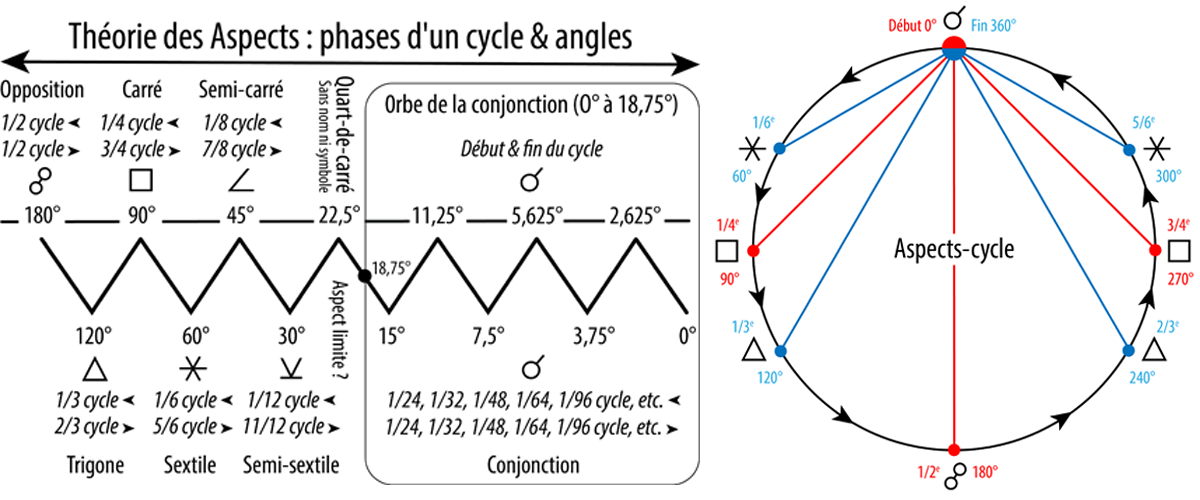
In the case of the conjunction, we see in the diagram above that this mathematical theory of Aspects also includes a theory of orbs, “the conjunction and its margin of action being determined both by divisor 1 (synergy) and by all the series of divisors beyond 16 (360°/16 = aspect of 22.5°, 360°/24 = aspect of 15°, etc.), corresponds to the phase of accumulation of the potentialities which will be expressed on the occasion of the different phases of the development of the aspects.” The question which then arises is to know what is the orb of a conjunction, which is the place of the accumulation of an infinity of minor Aspects. Being neither consonant nor dissonant, it is worth thinking that the border of this orb could be the arithmetic mean of two contiguous harmonics, one consonant and the other dissonant. Observation and practice show that this limit can be either between 22.5° and 15°, therefore at 18.75°, or between 15° and 11.25°, therefore at 13.125°.
We have seen that certain astrologers of the 19th century admitted a maximum orb of 15°, but only for conjunctions with the Sun. Those of the following century, and they are very divided on this subject, generally estimate it at a figure between 10° and 15°, a limit beyond which most begin to produce sweats of anguish in the face of the unknown. The limit could thus theoretically be set at 13.125°. A practice not indexed to the mental restrictions imposed by classical astrology on this thorny subject nevertheless pleads for an extreme limit of 18.75°. Almost all astrologers will consider this orb excessive. They are therefore invited to test it systematically and without prejudice. They may then realize, as the conditionalists, that there is nothing excessive about it.
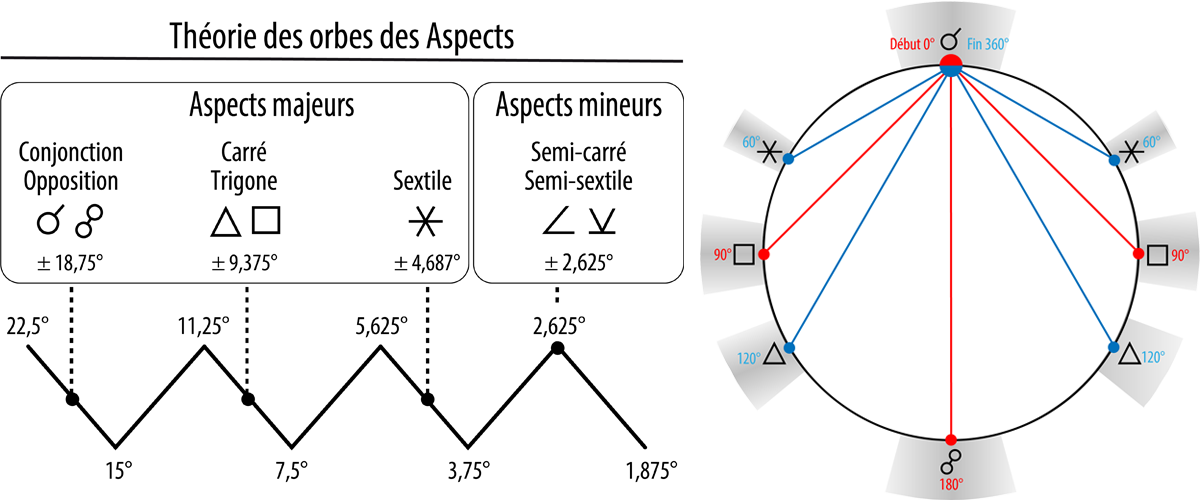
The second figure above is an illustration of the same method of arithmetic means, this time applied to the other Aspects. One can certainly contest the orbs thus admitted by considering them too extensive. But if for example we want to reduce these orbs to (7.5° + 5.625°/2 = 6.5625°) for the square-trines, we must then accept that the orb of the sextile is reduced to (5.625° + 3.75° = 3.18°), which the same protesters deemed insufficient. In practice it is therefore advisable, if one refers to this coherent theory, to admit orbs of 18° for the conjunctions-oppositions, 9° for square-trigons and 5° for sextiles, these numbers possibly being weighted and reduced according to the planets involved in an Aspect. Good theory is there to guide practice, and not to replace it and the reverse is also true: the observations nourish the theory and make it possible to improve its orientations.
The following table summarizes the mathematical formulas of Major & Minor Aspects, along with the high, mid, and low values of their orbs. It is better to consider Minor Aspects only between dominant planets. Among these, the Keplerian aspects are mentioned for information only and because they form part of the same harmonic family as the others. The maximum values of the orbs are recommended for the Aspects between fast planets (Moon to Mars included) and for those between angular planets. Medium values are suitable for Aspects between fast and slow planets, and minimum values for Aspects between slow planets.
The possibility of assigning high, medium and low values to the orbs according to the planets seems legitimized by observations drawn from practice. It means that if the effects of orbs specific to the Aspects themselves clearly predominate, these can be weighted by orbs determined by the planets themselves, depending on whether they have more or less short or long cyclic durations. These weights are part of ongoing research: the values given by the table above should therefore not be taken for eternal dogmas, but for stage guides.
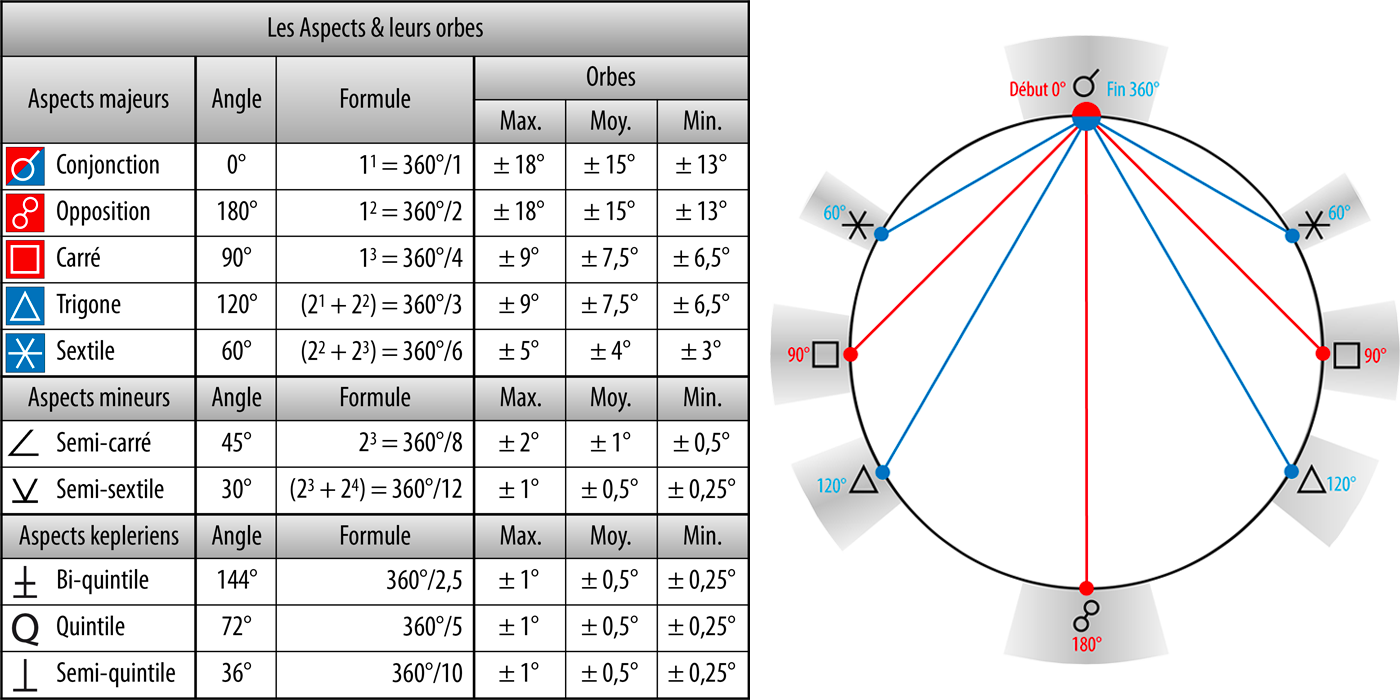
Finally, let us point out that this one and only consistent and coherent theory of Aspects excludes the sesquisquare and the quincunx, minor aspects which are not part of the same harmonic family as the major aspects and two other minor aspects, the semi-square and the semi-sextile. The sesquisquare of 135° and the quincunx of 150° are in fact only the result of additions of other Aspects: that of a square and a semi-square for the first, and that of a square and a sextile for the second.
In this conception, the Aspects and the Signs are considered as two distinct modalities of the same planetary cycle. And by integrating the Signs into this cycle, the ecliptic latitudes are taken into account this time, no to define the Aspects, but to define precisely when zodiacal phases they happen. This Aspect-Sign interaction within the cycle is thus a perfect illustration of the relevant or impertinent use that can be made of latitudes. Irrelevant in the case of the Aspects, taking them into account is relevant in that of the Signs.
Another issue is the effects of ecliptic latitudes on Signs. The graphs below will allow us, by visualizing it, to better understand this phenomenon. The left graph represents the Aspects-Signs association according to the conception of classical astrology. The Signs are static spaces of 30° each, each of them being defined by its belonging to one of the 4 Elements Fire-Earth-Air-Water. The Circle-aspects purely geometric combine these Elements in a mode “benefic” (conjunction, sextiles, trines) or “malefic” (squares, opposition).
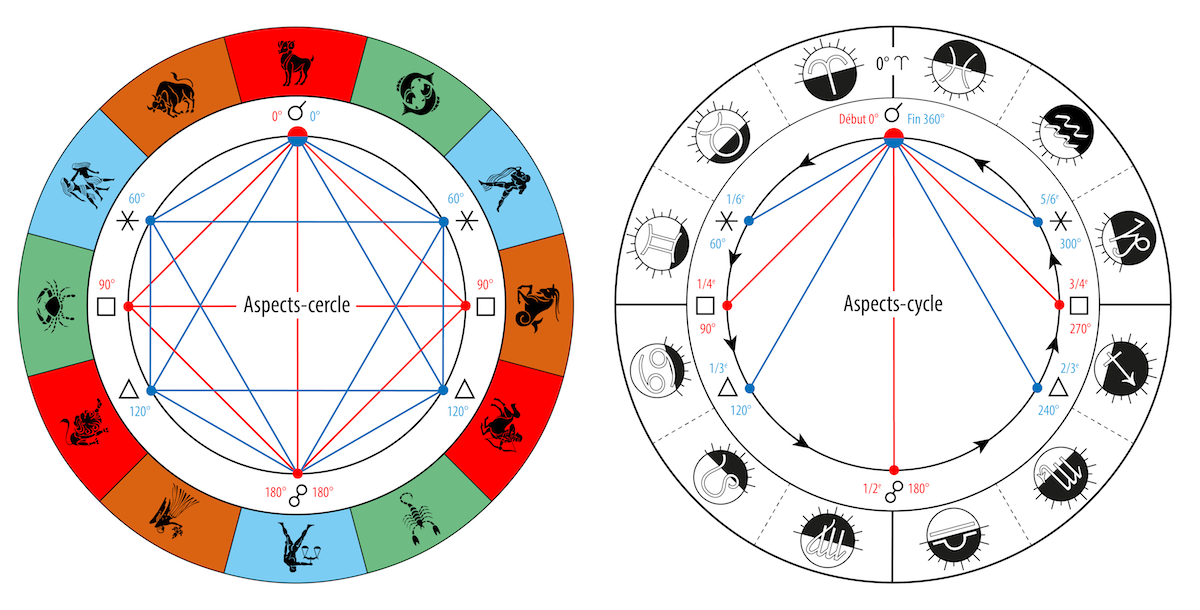
The right graph represents the same Aspects-Signs association, but according to the conception of the conditionalist astrology developed by Jean-Pierre Nicola. These are of course the Aspects-cycle dynamics that have been retained. As for the Signs, they are represented here under the chronological angle of their photoperiodicity for 45° North terrestrial latitude, i.e. the ratio of their daytime durations (time of presence of a planet above the horizon) and nocturnal (time of presence below the horizon), relationship induced by their variations. Aspectal and zodiacal phases are simultaneous and coordinated: the dynamics of the Aspects dictate, according to the zodiacal position of a planet at a given moment, the zodiacal phase which will characterize it during an Aspect at this position.
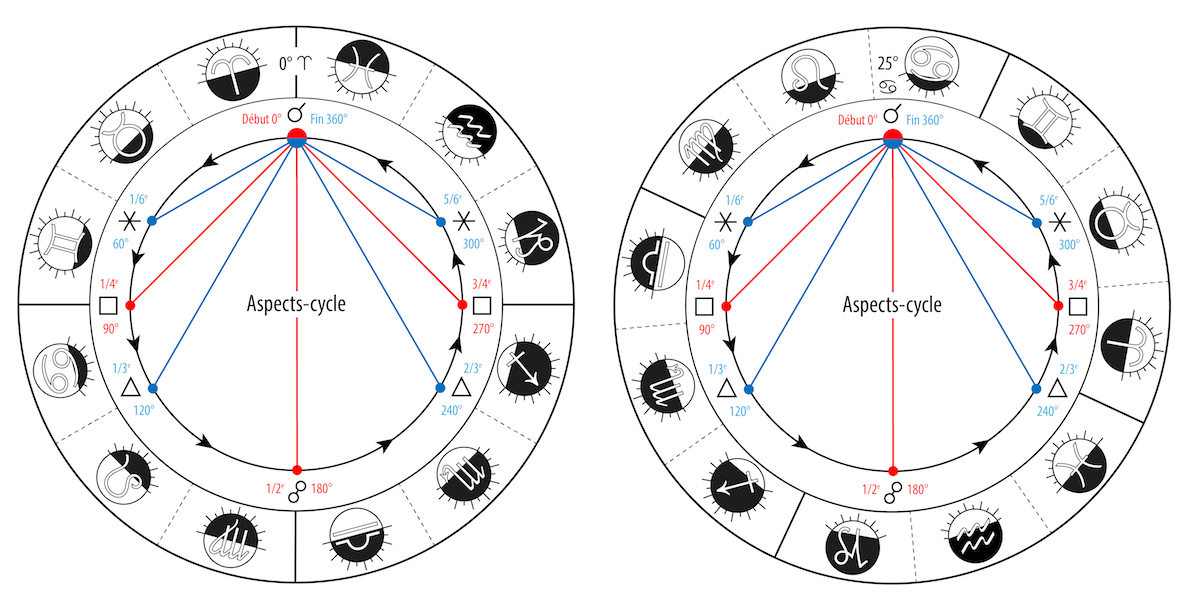
The fact that the conjunction and the 0° Aries or vernal point, origin conventional ecliptic longitudes, are located on the same point in the graph on the right should not be misleading: this is also only a convention. The two graphs above illustrate this. The one on the left is the one that appeared on the right of the previous illustration. The cycle of aspectal and zodiacal phases y began at 0° Aries. But the graph on the right shows that the aspecto-zodiacal couple can start at any point on the ecliptic — precisely where a planet is when it begins its cycle. Here this point is 25° Cancer. This origin chronologically implies that the first Aspect will be a thin Virgo sextile, the second a thin Libra square, the third a thin Scorpio trine, etc., provided that the planet concerned still has a ecliptic latitude none to very low during these Aspects in the Signs.
Otherwise, the planet in question may be, due to its high latitude, in a sign other than that indicated by its longitude. A planet having started its cycle of Aspects at 25° Cancer exactly on the ecliptic can thus, when it forms its first trine and that it has a strong southern latitude when it occurs, not being in Scorpio as the projection of its position on the ecliptic would suggest, but in Sagittarius. The latitudes, rightly neglected in the measurement of the Aspects, are therefore reintegrated into the planetary cycle through the intermediary of the Signs: each element is in its proper place, all are in interference and everything holds together.
The following graph is an example of the effects of ecliptic latitudes. It is a representation of the Declensions chart by Arthur Rimbaud. The dark blue sinusoid represents the ecliptic, surrounded by ecliptic band light blue (9° on both sides, but here very exaggerated). It is observed that all the planets have a very low latitude and are therefore very close to the ecliptic or on it, with the exception of the moon which has a significant northern latitude (+3° 45′ N), and Pluto (–16° 59′ S), at very high southern latitude. Hence the moon, apparently in Libra if we rely only on its longitude, is in fact above the equator, therefore with a Virgo declination (+1° 01′ N): she is therefore not in Libra, but in Virgo.
In this same graph, Pluto is in Taurus according to the projection of its position on the ecliptic plane. But due to its maximum southern latitude, it is actually far below the ecliptic band, and its declination (–3° 34′ S) is identical to that of the Sun at 21° Pisces. Pluto is therefore not in Taurus, but in Pisces… despite its Taurus longitude.
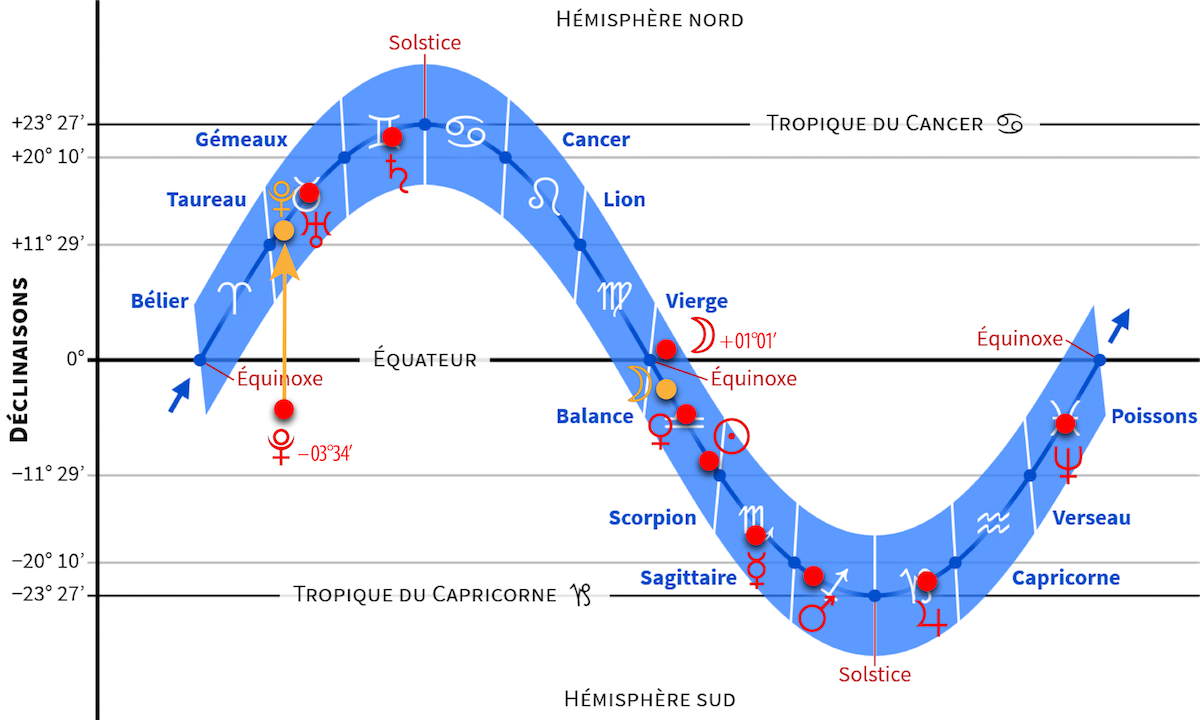
We see here the importance of ecliptic latitudes. A Moon in Virgo does not have the same effects as a Moon in Libra. And indirectly, a Moon-Venus conjunction in Libra produces different effects than the same Aspect between Virgo and Libra: via the zodiac, the latitudes therefore have an effect on the Aspects. A Moon-Venus conjunction in Libra can be considered a priori as rather consonant, while the same Aspect in Virgo-Libra is rather an index of dissonance, since these two Signs are the opposite of each other… The ecliptic latitudes therefore have an effect indirect on Aspects.
The Charts below are also maps of Rimbaud’s native sky. That of left is the classic Ecliptic chart, which does not allow the representation of the zodiacal latitudes but authorizes that of the Aspects. That of right is the House chart, based on both zodiacal latitudes and longitudes, which gives the actual positions in Houses according to the placidian domification, but does not allow a faithful representation of the Aspects, since these are only based on longitudes. We observe that Pluto is indeed lower above the horizon. But unlike the Declensions chart above, neither of these two sky charts allows us to directly see that the Moon has a Virgo declination and Pluto a Pisces declination. Each representation has its advantages and disadvantages.
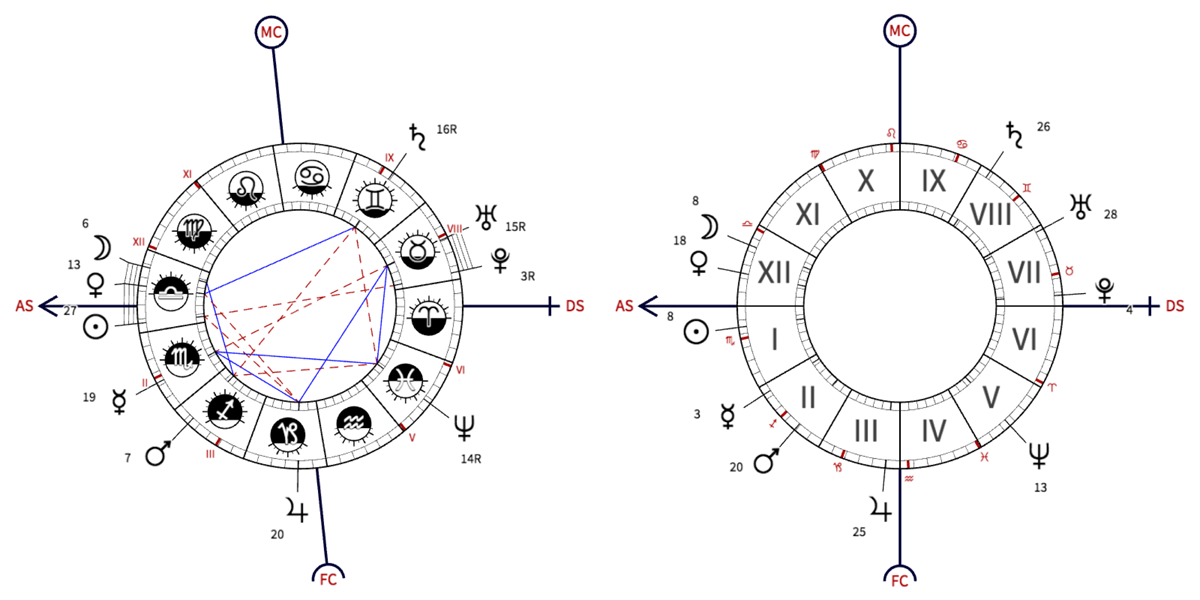
As an indication, the table below summarizes all the zodiac-planetary coordinates of the same chart. Not all have the same importance: longitudes, latitudes & declinations, ecliptic coordinates celestial sphere, are the most determining with regard to the Aspects & Signs. The latitudes, heights and azimuths provide information on the planetary positions in the local sphere and therefore in Houses. As for the right ascensions, they can for example avoid misjudging the astronomical effects of retrogradations. This table shows that we should not rely on longitudes alone.
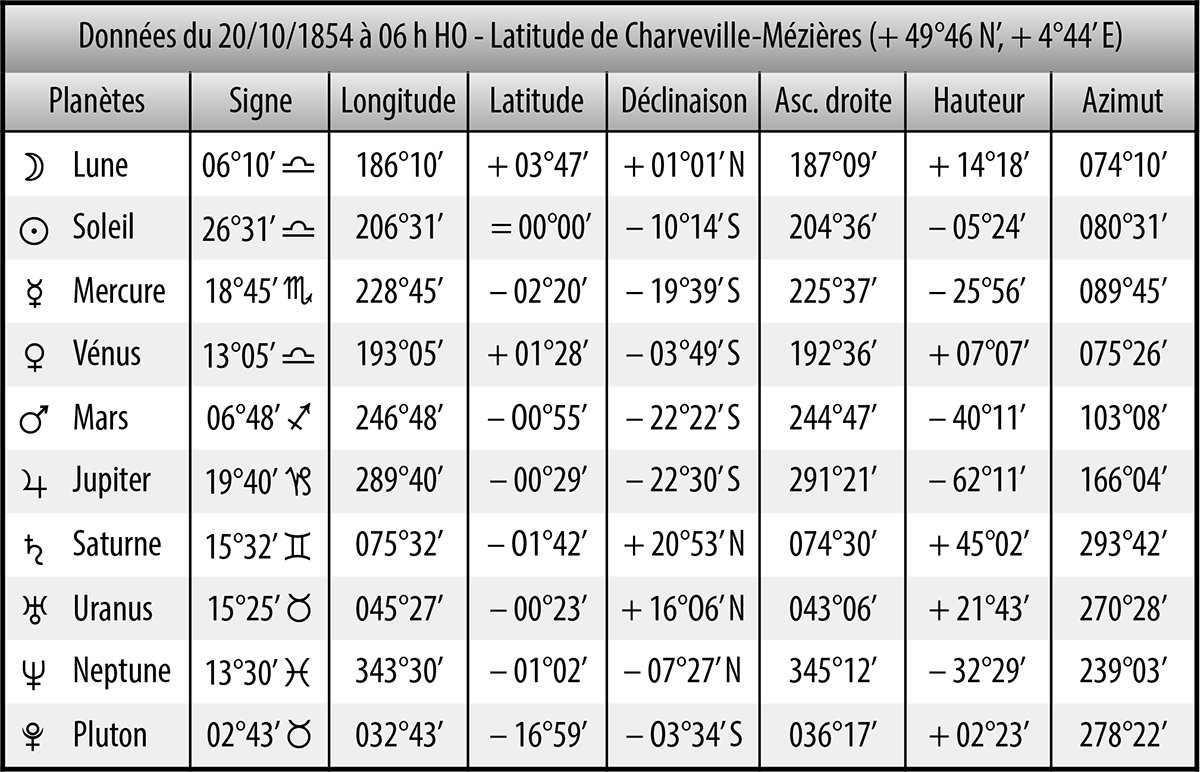
Such a integrative and dynamic conception of the Aspects and the Signs within the framework of the durations of the planetary cycles and intercycles is a considerable design innovation. From the point of view external, astronomical, ecliptic longitudes and latitudes are associated and coordinated with it, which had never before happened in the history of astrology. And from the point of view internal, reflexology, a rational correlation has been established between the Aspects and the functioning of the upper nervous system. We can of course continue to think and practice a symbolist astrology whose concerns are far removed from these astrometric and cosmographic considerations. But such a rigorous assessment, which is that of conditionalist astrology initiated by Jean-Pierre-Nicola, cannot be ignored, and its consequences underestimated: it profoundly renovates the foundations of traditional astrology.
The video below (7′ 03″) is a commented animation of the basics of traditional & modern interpretation.
This document does not claim to be a comprehensive study of the very long history of the astrological Aspects. Being neither a historian nor an academic, I could only use the resources of my library and do research on the Internet to write it. A more in-depth study carried out by researchers with access to the resources of major archival libraries would probably, for example, make it possible to specify the dates of the main developments of the notion of Aspect between the 2nd and the 17th century, of which I have here only indicated the main stages.
He is nevertheless here demonstrated that the current concept of Interplanetary Aspect is the result of an evolution of more than two millennia. In view of this long duration, it is only recently that this concept really emerged from concept initial privileged zodiacal distance which has long been the only way to consider the angular relationships between planets.
It can be seen that during these centuries, astrologers have always preferred ecliptic longitudes for the calculation of zodiacal angles and Planetary Aspects. Rare are those who have mentioned the ecliptic latitudes of the planets, and rarer still have been those who have been in favor of taking them into account for the measurement of these angular distances. And it’s probably for a mix of good and bad reasons that longitudes were the only ecliptic coordinate retained.
Let’s start by listing these reasons. The first is neither good nor bad but relates to the inherent constraint the initial notion of zodiacal angle. This angle coming under plane geometry, that is to say in two dimensions, it logically excluded the third dimension that the ecliptic latitude. Ptolemy did not inscribe polyhedrons in a sphere, but polygons in a circle.
Good or bad, the other reasons are implicit rather than explicit, since they have never been explained until the 20th century. The most obvious is that the measurement of longitudes is much simpler and faster than that of latitudes which required very long and tedious calculations. But this reason could only begin to be credible when the planetary Aspects were no longer confused with the zodiacal angles, so very late. And moreover, the astrologers aware of this problem and not evading it were all either also astronomers or keen on astronomy at the time concerned. If they consciously or unconsciously made this implicit choice, it was certainly not because of their ignorance of latitudes and their possible or proven effects on the ecliptic angles they were measuring. It is very likely that practice and the resulting observations have prompted the most discerning of them to retain only the single criterion of longitudes to calculate the Aspects. As for the others, they probably only reproduced the tradition.
Finally, among the good and/or bad reasons for this preference for longitudes, we can think of the long-held confusion between circle and cycle, between the phases of the cyclic kinematic time of the real of the planetary Aspects and the static geometric space of their instantaneous representation in the charts of the sky.
The appearance of printed ephemeris only reinforced this trend. Their relative ease of use was based on the exclusion of latitudes. But the persistence of the notion of zodiacal angle was probably one of the reasons for this implicit choice of longitudes. It in fact encouraged those astrologers who used these astronomical tables without asking questions (the majority) to consider the relationships between the planets only in their projection on the ecliptic plane and to disregard an absent coordinate, latitude. It is moreover still the case in modern ephemerides, which only provide information on longitudes, and incidentally on declinations. It is only by consulting the figures of the latter that one can, by deduction, find the latitudes.
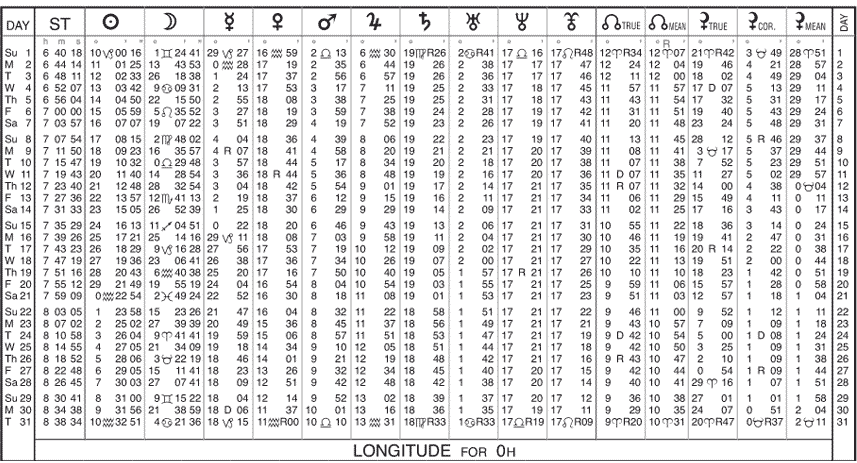
But reality is paradoxical, and the discoveries about it are very frequently the result of a dosage of good and bad reasons intertwined, the good ones advancing sometimes masked under the cover of the bad ones. The role of the serendipity which is, with that of its occasional companion the intuition, essential in the history of scientific discoveries. The inventor of this concept, Horace Walpole, defined it as a synonym for “accidental sagacity”. The definition given Wikipedia conforms to this original and original strict sense: “conjunction of lucky chance which allows the researcher to make an unexpected discovery of importance or of greater interest than the object of his initial research, and of the ability of this same researcher to seize and exploit this ‘chance’.”
Did the learned astrologers-astronomers of the past demonstrate serendipity, from “accidental sagacity” by privileging the ecliptic longitudes in the calculation of the Aspects? It seems very likely. Their “initial research” in this area was geometric in nature and conditioned by their belief in zodiacal angles which corresponded with musical intervals and which they confused with the Planetary aspects. However, these learned initial hypotheses turned out to be erroneous… but they led despite themselves to a major discovery: it is indeed the ecliptic longitudes which count in the measurement of the Aspects, but not at all for the geometrical reason which had guided them. In their case, one could thus diagnose a “unconscious accidental sagacity”, in the sense that they have no never realized what they had discovered. What is a particular case of serendipity probably more frequent than we imagine, this polysemous notion covering various interpretations of the role of chance in discoveries.
The serendipity always thwarts the initial hypotheses and the initially determined plan of the researcher. This one looks for a thing and while doing so accidentally discovers something or “by chance” another that has or does not have a direct link with the thing initially sought. The talent of the discoverer then lies in his ability to “seize and exploit this ‘chance’”. It cannot be said that the astrologers of the past had this ability. They never understood that they had discovered the primacy of longitudes over latitudes for good reasons.
Did anyone ever have the intuition? If so, there is no documented record of it, except in Kepler, who belatedly realized that “the laws and periods of the cycles should be investigated by collecting observations made over many years.” By this formulation, he opened the field to a conception temporal, cyclic of the Aspects which legitimized the use of longitudes alone to measure them, as we have demonstrated. And it was only three centuries later that the researcher-astrologer Jean-Pierre Nicola was finally able to take advantage of this “accidental sagacity” astrologers of the past and finally give a relevant interpretation.
In conclusion and in summary, this historical overview about the Aspects and their orbs, as well as the zodiacal angles of declination (antisces and counter-antisces) allowed us to determine the influence or non-influence of the ecliptic latitudes on these elements, namely that:
1) Ecliptic latitudes are not not a relevant coordinate to measure the Aspects, which are not geometric angles in a static space as astrologers have long believed and thought, but the characteristic moments of the phases of a planetary cycle or intercycle in a dynamic temporality; consequently the Aspects are exclusively measured on the ecliptic plane and in relation to the longitudes determined by it;
2) Ecliptic latitudes are one relevant coordinate to measure antisces and counter-antisces, which are therefore not Aspects, but the smallest units of measurement, expressed in degrees, of the antiscial or counter-antiscial character which qualifies the pairs of Signs mirrored on either side of the equinoctial or solstitial axes in the zodiac variations.
3) The Aspects and variations of the Signs, which induce the photoperiods of these, are the two periodic characteristics of the same planetary cycle or intercycle. By thus associating Aspects and Signs, the two ecliptic coordinates that are longitude and latitude are also taken into account. The Planet-Sign-Aspect trio, whose elements must be analytically dissociated in order to determine the coordinates specific to each of them, thus constitutes a synthetic reality.
The use of ecliptic latitude is therefore relevant in the case of antisces and counter-antisces, and irrelevant in the case of Aspects. Many astrologers of the past would have been delighted to know that they had a correct intuition leading in spite of themselves to knowledge that they never formulated. The astronomical-astrological unity of this Planet-Sign-Aspect trio as a cycle structured by periodic phases did not have until the 20th century never been demonstrated. It is now done and the cognitive adventure continues in this field of astrology as in all the others.
▶ Aspects theory and practice
▶ Les aspects, phases d’un cycle
▶ Aspects : existe-t-il un modèle traditionnel ?
▶ Aspects : théorie et bilan conditionaliste
▶ Introduction à l’interprétation des aspects
▶ The planetary Aspects and their orbs
▶ Les Aspects kepleriens
▶ Les “aspects” aux Angles
▶ Chronologie des Aspects et Transits
▶ Les Aspects planétaires
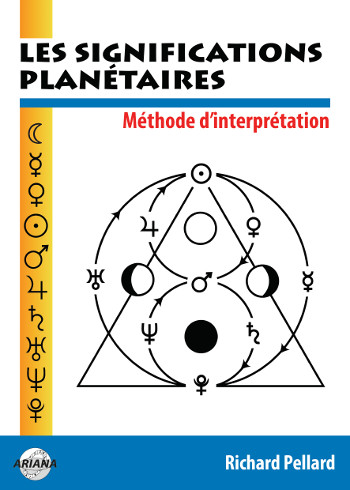
Les significations planétaires
par
620 pages. Illustrations en couleur.
La décision de ne traiter dans ce livre que des significations planétaires ne repose pas sur une sous-estimation du rôle des Signes du zodiaque et des Maisons. Le traditionnel trio Planètes-Zodiaque-Maisons est en effet l’expression d’une structure qui classe ces trois plans selon leur ordre de préséance et dans ce triptyque hiérarchisé, les Planètes occupent le premier rang.
La première partie de ce livre rassemble donc, sous une forme abondamment illustrée de schémas pédagogiques et tableaux explicatifs, une édition originale revue, augmentée et actualisée des textes consacrés aux significations planétaires telles qu’elles ont été définies par l’astrologie conditionaliste et une présentation détaillée des méthodes de hiérarchisation planétaire et d’interprétation accompagnées de nombreux exemples concrets illustrés par des Thèmes de célébrités.
La deuxième partie est consacrée, d’une part à une présentation critique des fondements traditionnels des significations planétaires, d’autre part à une présentation des rapports entre signaux et symboles, astrologie et psychologie. Enfin, la troisième partie présente brièvement les racines astrométriques des significations planétaires… et propose une voie de sortie de l’astrologie pour accéder à une plus vaste dimension noologique et spirituelle qui la prolonge et la contient.
Téléchargez-le dès maintenant dans notre boutique
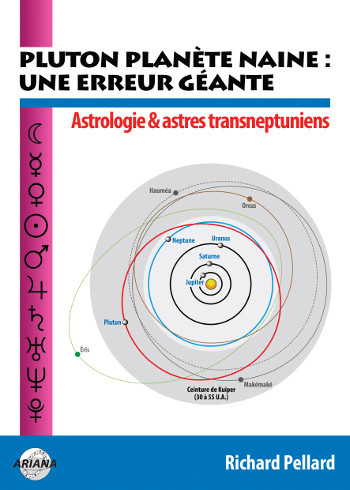
Pluton planète naine : une erreur géante
par
117 pages. Illustrations en couleur.
Pluton ne fait plus partie des planètes majeures de notre système solaire : telle est la décision prise par une infime minorité d’astronomes lors de l’Assemblée Générale de l’Union Astronomique Internationale qui s’est tenue à Prague en août 2006. Elle est reléguée au rang de “planète naine”, au même titre que les nombreux astres découverts au-delà de son orbite.
Ce livre récapitule et analyse en détail le pourquoi et le comment de cette incroyable et irrationnelle décision contestée par de très nombreux astronomes de premier plan. Quelles sont les effets de cette “nanification” de Pluton sur son statut astrologique ? Faut-il remettre en question son influence et ses significations astro-psychologiques qui semblaient avérées depuis sa découverte en 1930 ? Les “plutoniens” ont-ils cessé d’exister depuis cette décision charlatanesque ? Ce livre pose également le problème des astres transplutoniens nouvellement découverts. Quel statut astrologique et quelles influences et significations précises leur accorder ?
Enfin, cet ouvrage propose une vision unitaire du système solaire qui démontre, chiffes et arguments rationnels à l’appui, que Pluton en est toujours un élément essentiel, ce qui est loin d’être le cas pour les autres astres au-delà de son orbite. Après avoir lu ce livre, vous saurez quoi répondre à ceux qui pensent avoir trouvé, avec l’exclusion de Pluton du cortège planétaire traditionnel, un nouvel argument contre l’astrologie !
Téléchargez-le dès maintenant dans notre boutique